Food and its Components | General Knowledge Encyclopedia - Class 8 PDF Download
Food and its importance
Food is essential for all living organisms. Plants prepare their own food and store in their special organs as fruits, tubers, seeds, etc. Animals and human beings depend on this stored food of plant. Bigger animals depend on smaller animals for their food. Human beings also depend on animals for their food.
Importance of food
- Food provides energy.
- Food is needed for growth.
- Food helps in maintaining good health.
- Food maintains body functions.
- Food is necessary to heal wounds.
Ingredients
- Food comprises of ingredients. An ingredient is a part of mixture that is added to prepare a dish. Ingredients vary with different types of food. Ingredients can be obtained from plant sources and animal sources.
- Example: To prepare boiled rice, rice and water are used, so rice and water are the ingredients for boiled rice.
- Vegetables, salt, water and spices are used in cooking vegetable curry, so vegetables, salt, water and spices are ingredients of vegetable curry.
Vegetable Curry = Vegetable + Water + Salt + Spices
Nutrients
Food comprises of essential nutrients namely, carbohydrates, proteins, fats, vitamins and minerals. Carbohydrates and fats are called as energy providing food. Proteins are called as body-building food. Vitamins and minerals are called as protective food.
Plant Food Products
Plant food products are the different types of food that we get from plants. Green plants are the primary source of food. Plants provide us with vegetables, fruits, cereals, pulses, spices, nuts, oils etc.
Edible parts of the plant
Almost all parts of the plants such as leaves, stems, roots, fruits, and seeds are considered to be edible parts.
- Roots: We eat plant roots in the form of carrot, turnip, radish and beetroot.
- Stem: We eat stems of some plants as in sugarcane, coriander. One form of stem tuber is potato. We also eat underground stem in the form of ginger.
- Leaves: Many green leaves are the sources of calcium. Some leaves that we eat are spinach, cabbage, amaranthus, curry leaves etc. Onion is also a form leaf which is underground.
- Flowers: Flowers of pumpkin, cauliflower are edible flowers. Some types of roses are also edible.
- Fruits: We get edible fruits from many plants. Fruits can be fleshy fruits or dry fruits. e.g. mango, guava, orange, apple, pear, grapes, banana etc. Almonds, cashew nut are used as nuts. Some fruits are used as vegetables. Some of them are brinjal, tomato, lady’s finger, beans, bottle guard, snake gourd, bitter gourd etc.
- Seeds: Seeds which are edible can be used as grains, pulses and oil seeds. Grains include rice, wheat, jowar, maize, ragi etc. Pulses include grams, peas, beans etc. Oil seeds include groundnut, sesame, mustard, coconut, sunflower seed etc.
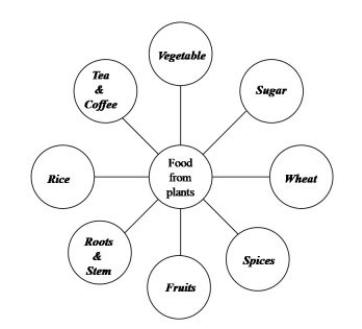
Animal Food Products
- Animal food products are the different types of food that we get from animals. Animals provide us with different products like milk, eggs, poultry, meat, honey etc. Animals obtain their food from plants or other animals.
- Poultry farm is the place used to rear birds for their eggs and meat.
- Dairy farm is the place where buffaloes, goats, cows, sheep, pigs etc are kept in shed for rearing. We rear animals for their milk and meat. Milk is also used to prepare dairy products.
- Aquaculture includes rearing of fish, crabs, lobsters etc. Fish provide their meat for us. Fish can be marine or freshwater fish.
Edible animal products
- Milk: Animals like cows, buffaloes, goat, camel provide us their milk. Milk is rich in proteins, fats, carbohydrates, vitamins and minerals. It is called as complete food as it has all the nutrients.
- Eggs: Eggs are rich source of proteins. We get eggs from birds like hen, duck etc.
- Meat: Flesh of animals is called as meat. We get this form hen, duck, sheep, goat, pig, cow etc.
- Sea food: Fish, prawns, crabs also provide us their meat as food.
- Honey: This is the food product obtained from honey bees. They collect nectar from different flowers, mix it with a secretion from their mouth and convert it into honey. Bees store this honey in their bee hives.
- Dairy products: The products which can be made from milk are called as dairy products. Some common dairy products which we use in our daily life are paneer, cheese, cream, butter, curd, ghee etc.
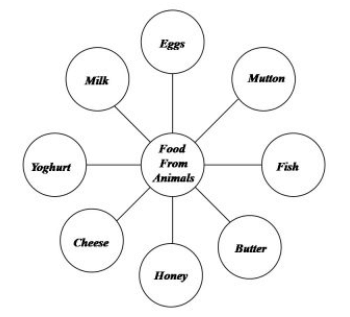
Animals and their food
Based on food they eat, animals are grouped into three groups namely, herbivores, carnivores, omnivores and decomposers.
- Herbivores: Animals which eat only plants are called as herbivores. These are also called as grass-eating animals. e.g. Cow, sheep, goat, deer, buffalo, camel etc.
- Carnivores: Animals which eat only small animals are called as carnivores. These are also called as flesh-eating animals. e.g. Tiger, lion, jackals, vultures etc.
- Omnivores: Animals which eat both plants and animals are called as omnivores. e.g. Human being, bears, crows etc.
- Decomposers: Organisms which feed on dead plants, dead animals and rotten materials for their food are called as decomposers.
Food Habits in Human Beings
Human beings, based on the type of food they eat are grouped into two groups namely, vegetarians and non-vegetarians.
- Vegetarians: These are the individuals who depend on plants and plant products for their food. The vegetarian diet comprises only pulses, grains, cereals, fruits, vegetables.
- Non-vegetarians: These are the individuals who depend on animals and animal products for their food. Non-vegetarian diet comprises eggs, meat, fish, poultry etc.
Components of Food – Nutrients in Food
There are seven essential components or substances called nutrients in our food. These are:
- Carbohydrates: These are the common energy-giving compounds. Foods rich in carbohydrates are potato, sweet potato, bread, rice, wheat, honey, common sugar, jaggery(gur) and milk. Most processed foods like pizza, burger, jams, jellies, and noodles are rich in carbohydrates.
- Fats: These are also energy-giving foods, producing more energy than carbohydrates. Fat-rich foods are (i) milk products such as butter and cheese, (ii) vegetable oils such as coconut oil, groundnut oil, (iii) nuts, (iv) milk and (v) animal fat from meat. Fats provide more than double the energy provided by carbohydrates or proteins.
- Proteins: These are body-building foods. Proteins help the body in its growth and repair of body cells and tissues, protect and help the body to fight against infections and regulate body functions. Protein sources of plant origin include pulses (soyabean, peas) and to a lesser extent cereals. Meat, eggs, cheese, milk and fish provide proteins of animal origin.
- Mineral salts: Mineral salts are important for various body functions. They are required in small quantities and are obtained from the food we take in. Minerals have no energy value. Rich sources are milk, cheese, green leafy vegetables (like spinach), pulses, meat and eggs. Salts of calcium and phosphorus are required for making bones and teeth hard and for promoting blood clotting. Iron is essential for forming haemoglobin, a component of our blood, the deficiency of which causes anaemia. Green leafy vegetables, eggs, groundnuts, and liver are good sources of iron. Iodine, another mineral, controls the functioning of an important gland, thyroid. Deficiency of iodine leads to goitre. Iodised salt, fish and seafood are the sources of this mineral.
- Vitamins: Vitamins are neither body-building nor energy-giving foods, but are very important for proper functioning of our bodies. They are required by the body in very small quantities. Green leafy vegetables, fruits, milk, eggs and cheese are rich in vitamins.
- Water: Water is indispensable. About 70 per cent of our body weight is that of water. It helps the body in various functions. It is a means of transporting substances in the organism. It helps to maintain a constant body temperature. Water helps in the absorption of food and excretion of waste products from the body. Our body needs 2-3 litres of water every day.
- Roughage (Fibre): Fibre is found in vegetables, fruits, beans and cereals. It has no nutritive value, but prevents constipation and is necessary for proper functioning of the digestive system.
Food Nutrients — Functions, Sources, and Daily Needs
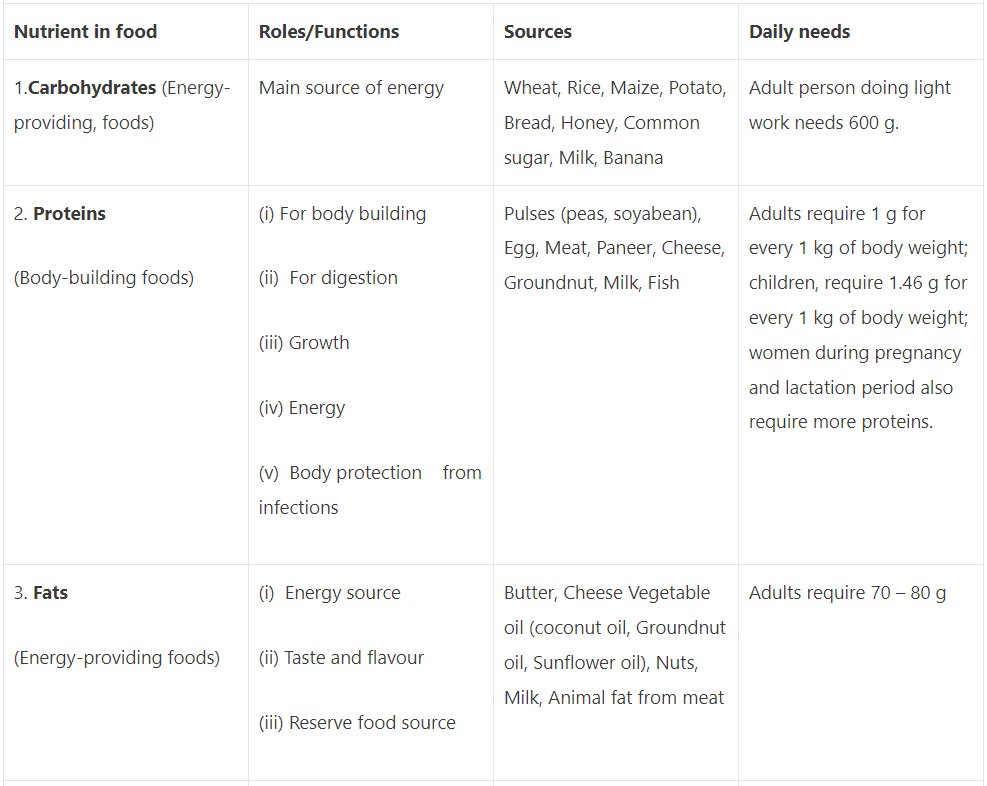
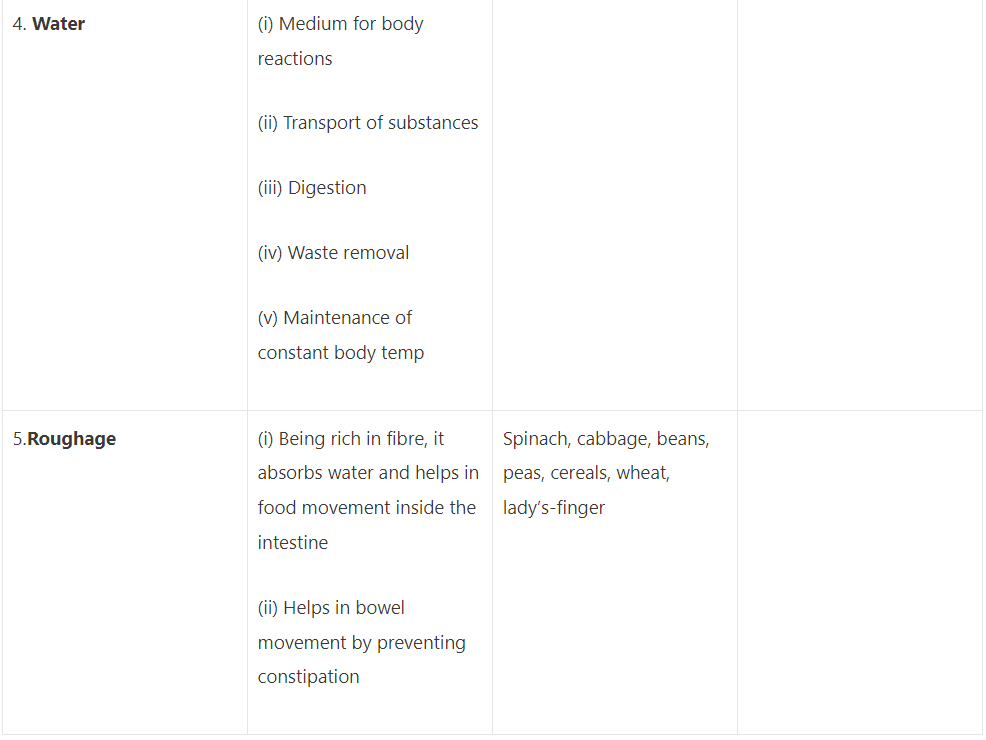
Minerals-Sources, Functions, Deficiency Effects and Daily Needs

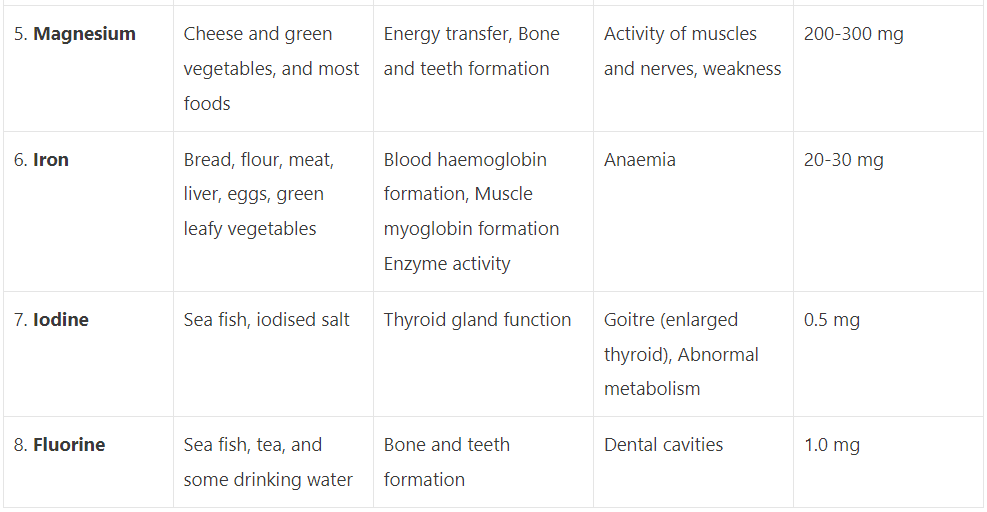
Vitamins — Sources, Functions, Deficiency Disease and Daily Needs

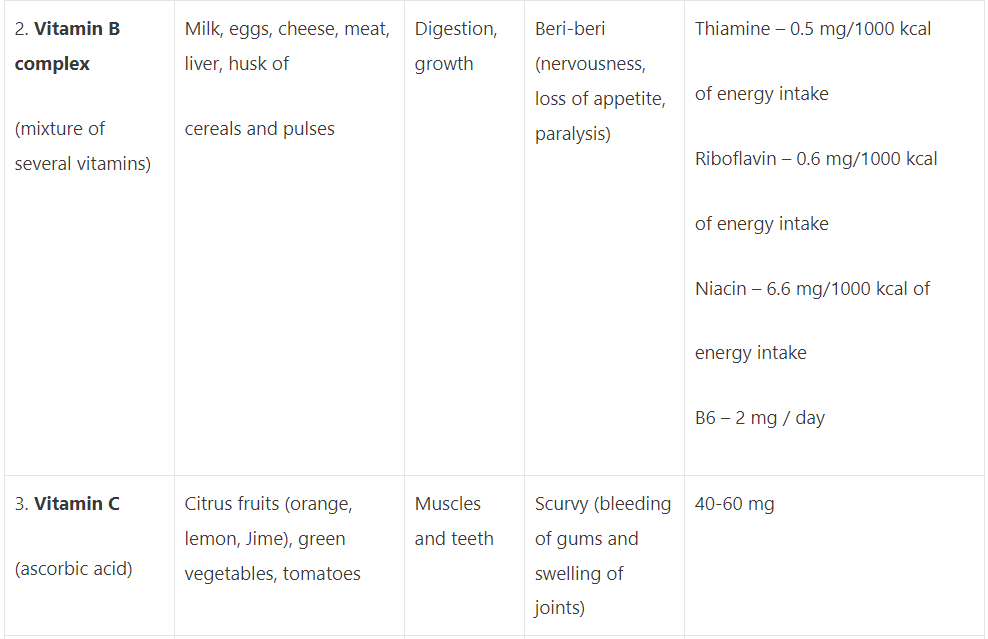
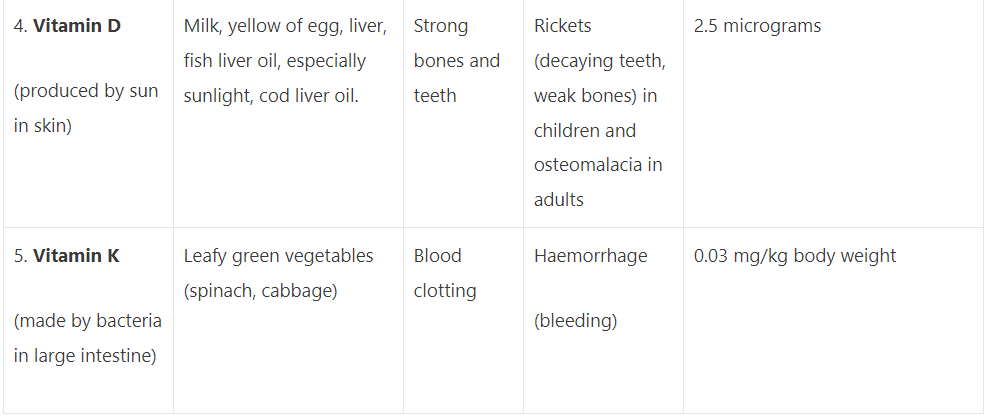
Types of Food Based on their Role
Foods, on the basis of their role in the body, are classified into three major food groups:
- energy-giving foods (like carbohydrates and fats)
- body-building or growth-promoting foods (like proteins), and
- protective foods (vitamins and minerals).
No single food can supply all the components required for proper nutrition. Food items included under these three food groups are given in Table and shown in Figure.
Food items included in three major Food Groups

Composition of Some Food items
Below given table gives the percent composition of nutrients per 100 g of different food items.
Foods and their Energy Values
When food is eaten, it is broken down into simpler compounds, and in this process energy is produced.
The energy producing life function in living organisms is known as respiration.
For instance, when sugar, a simple form of carbohydrate, is burned in air, it produces heat and light as energy. Carbon dioxide and water are also produced as by-products. Similar reaction takes place, if glucose is burnt in place of sugar.
Similar reaction takes place, if glucose is burnt in place of sugar.
This process occurs inside our body too, during the process of respiration, but with the following modifications:
1. Inside the body, the breakdown of glucose or sugar does not take place in one step as in burning. Instead, it occurs in several steps.
2. Secondly, the energy is also released in small packets, without raising body temperature.
3. Thirdly, inside the body, certain protein molecules, called enzymes, take part in the process of breaking down food molecules. This does not happen in burning.
Thus, one of the major functions of food is to produce energy. Different foods produce different quantities of energy. The energy in foods is measured by a unit called Calorie.
Note:
1 kilocalorie (kcal) = 1000 calories
1 calorie =4.18 joule 1000 joules = 1 kilo joule (kJ)
The energy value of foods:
- Fats: 9 kcal/gram or 37 kilojoules
- Carbohydrates: 4 kcal/gram or 17 kilojoules
- Proteins: 4 kcal/gram or 17 kilojoules
Water is the only nutrient that supplies no energy.
Calorific values of some individual food items, the energy used up in different activities are given in Tables.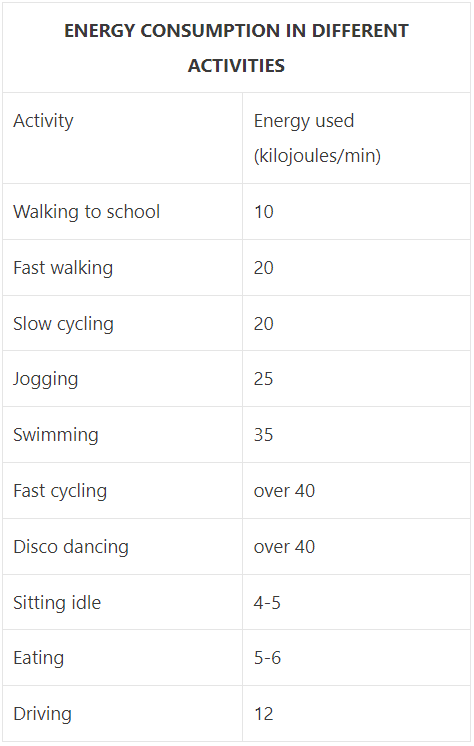
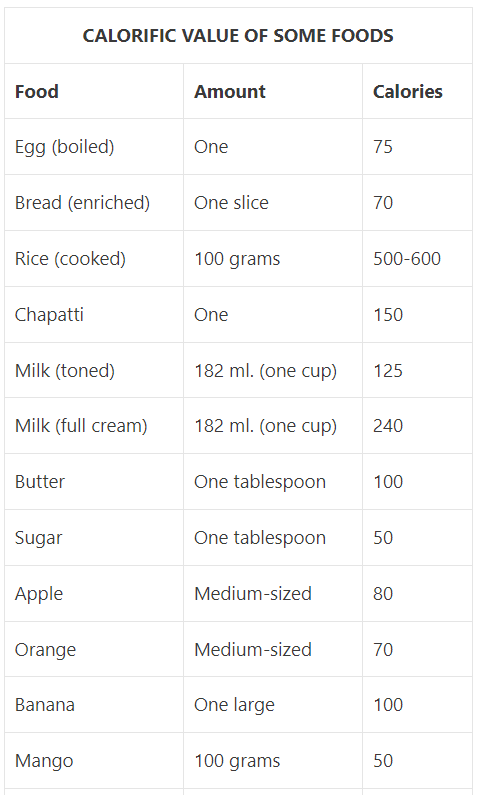

Who needs more Food?
- A person doing hard physical work requires more energy. So, a greater carbohydrate content is required.
- Pregnant women need more nutrients. The child growing inside, needs
- (i) proteins for growth, (ii) calcium for the bones, (iii) iron for the blood.
- For breast-feeding the baby, the nursing mothers need more of
- (i) calcium, (ii) protein-rich milk, (iii) vitamins.
- Growing children need more food in proportion to their body weight.’ See Table to know how much energy is spent in different activities which children generally perform.
Table shows the average daily requirements of energy by people of different age groups.
Different people need different amounts of food energy. Their calorie needs are different. Some people need more calories than others.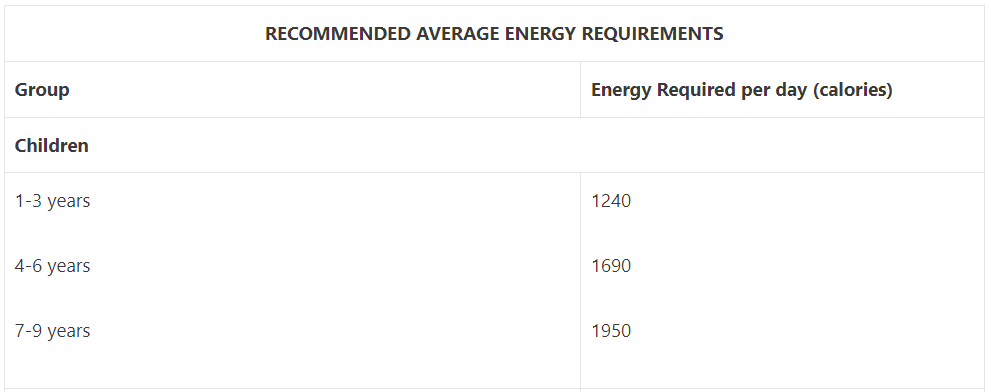
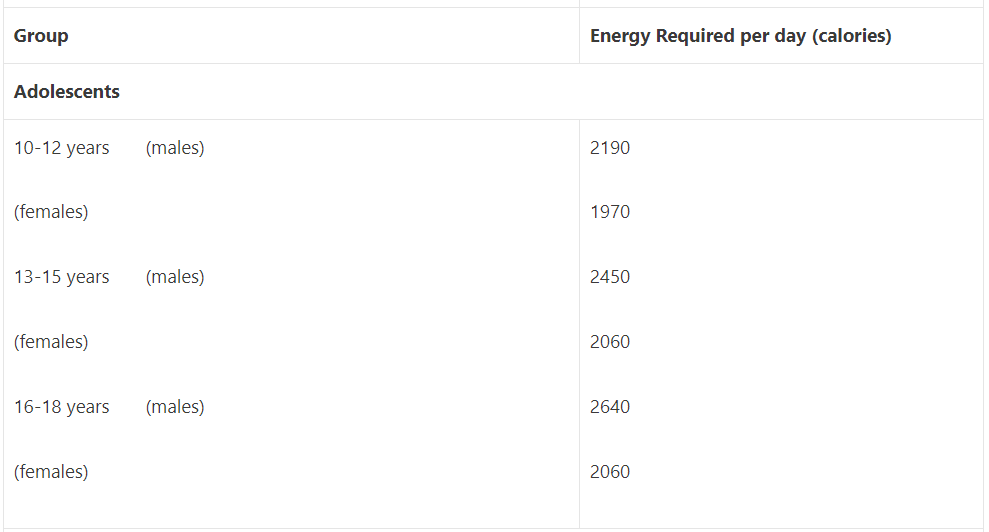
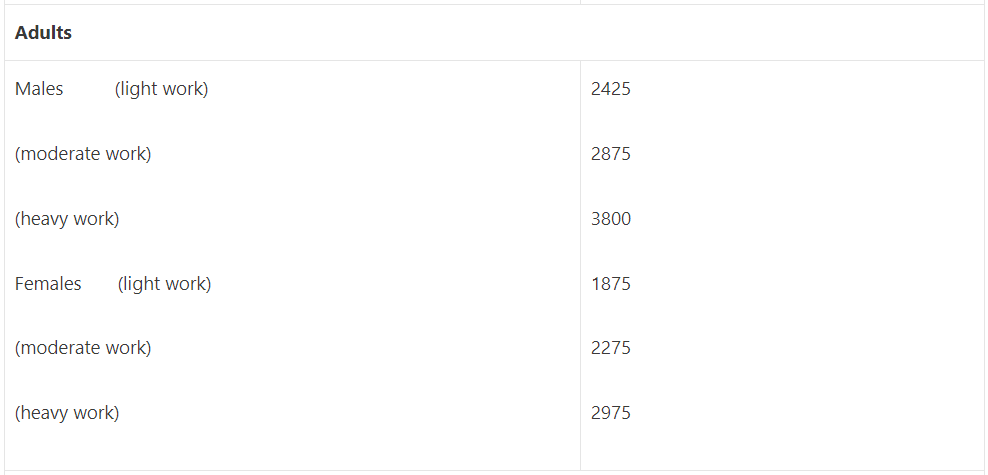

The number of calories a person needs depends on many things. Here are a few:
- Age: Young people need extra energy because they are very active. Extra calories are also needed for their growth.
- Weight and Size: Tall people need more calories than the small ones.
- Activity: An active adult needs more calories than an inactive adult. For example, a labourer needs more calories than a clerk. Adults who play sports need extra calories.
- Temperature: The body uses energy to maintain a normal temperature. In cold climates, extra calories are required to maintain this temperature.
Balanced Diet
Our body requires balanced quantities of proteins, carbohydrates, fats, vitamins and minerals for its proper growth and maintenance. Deficiency of one or the other nutrient in the food leads to poor health, and makes it prone to disease. Deficiency of food in terms of quantity, or under nutrition as it is called, may lead to starvation. Inadequate diet results in the loss of weight, and the person’s digestive system gets affected. Often a person suffers from diseases due to improper intake of food. The food taken in may be deficient in essential nutrients due to wrong food habits. This is known as malnutrition.
Some eat only rice while others prefer chapaties or bread. Illiteracy adds to the problem. A mixed diet containing all the essential nutrients in the right proportion is necessary for body’s proper growth. Such a diet is known as a balanced diet. A balanced diet, thus, provides the body with
(a) all the essential nutrients,
(b) all the materials necessary for proper growth and repair of body,
(c) energy required by the body to carry out its life activities, and
(d) extra nutrients to withstand short period of fasting.
Over-eating may also lead to diseases. Obesity is one such disease. This often leads to other problems like heart diseases and high blood pressure.
Also, a balanced diet is related to one’s age, health and occupation. For example, a labourer needs more carbohydrates and fats in his diet which would provide him more energy. A young child should take more proteins, as they help in body building.
Food Additives
When some foods are manufactured, chemicals are put in them. These chemicals are called food additives.
Food additives have no nutritional value. They are added for a number of reasons.
- As colourings: These make the food look more attractive. Tinned peas arid strawberries, for example, owe their colour to these chemicals.
- As preservatives: These slow down the rate at which foods go bad and keep the food fresh. Thus, the foods can be carried to long distances.
- As flavourings: These restore the flavour of the food that is often lost when it is processed.
Most additives are harmless. Some additives may cause headache, asthma, mage to organs such as the liver and kidneys and even cancer.
Food Fads
- Food forms an essential part of our daily life. A considerable part of our time and money is spent in selecting and purchasing foods.
- We are exposed to a variety of information and views about the foods and their nutritional value through newspapers, magazines, books, advertisements id through conversation.
- Our views are influenced by what we hear and see. Very often, expensive foods are considered more nutritious and good for health than less expensive foods. Similarly foods which are difficult to obtain are considered better than easily available ones. Such wrong notions prevail in our society.
- Misinformation or wrong and unscientific information about food is termed food fads.
- Some of the food fads have arisen in due to certain customs, traditions and wrong beliefs.
- Expensive vs. inexpensive food – grapes vs. spinach
- Let us take the example of two food items — the expensive grapes and the inexpensive leafy green vegetable spinach (palak).
- The nutrients present in 100 grams of grapes and spinach are listed in given table.
- Spinach contains much more proteins, fats, minerals and vitamins than grapes. It clearly proves that spinach is more nutritious than the costlier grapes.
- Similarly, cheaper fruits like bananas and guavas have a greater nutritive value than more expensive fruits like grapes and pomegranates.
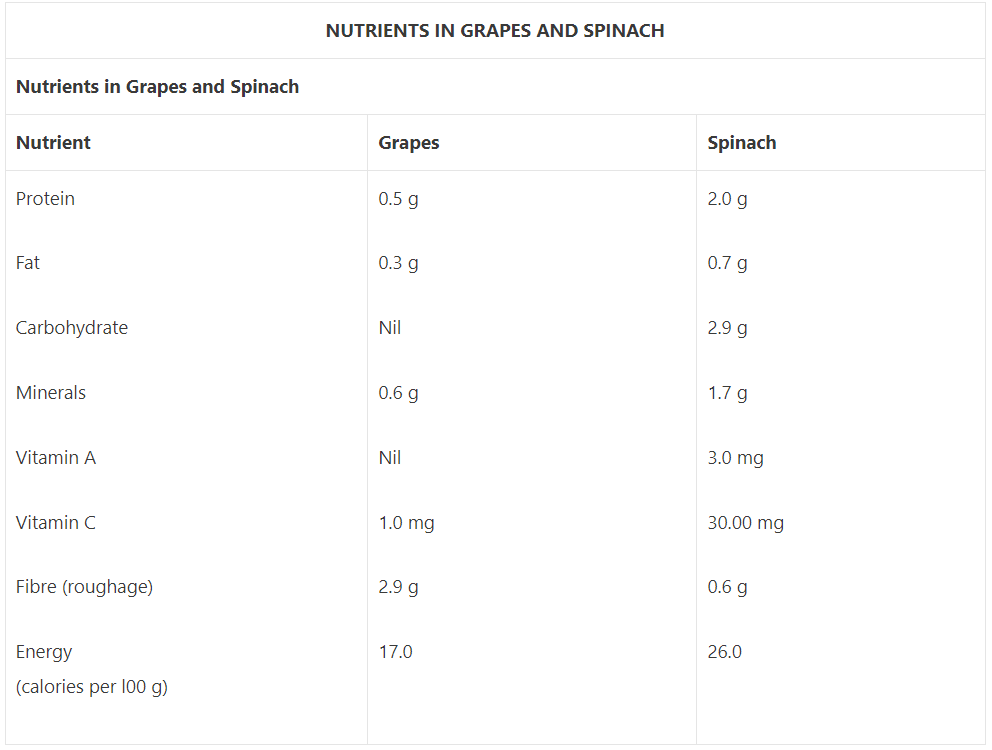
Food Fads about Cereals and Cereal Products
- There is a common misconception that starchy foods like rice and bread are calorie-dense. As a result, many people attempting to lose weight tend to reduce or eliminate cereals from their diet. However, it's essential to understand that cereal foods such as chapatti or bread themselves are not high-calorie sources. The real culprit for increased calorie intake comes from the toppings and accompaniments like ghee, butter, cheese, jam, sugar, and chutney. To achieve effective weight management, it is crucial to avoid these high-calorie additions.
- Another misconception is that switching from rice to bread or chapatti can aid in weight reduction. In reality, both rice and wheat contain similar calorie content, and merely replacing one with the other will not lead to any significant difference in calorie intake. The key to successful weight reduction lies in overall calorie reduction rather than focusing solely on the type of staple food consumed.
Food Fads about Oils and Fats
Some manufactures claim and suggest that people should use a particular brand of vegetable oil, as it has a high content of poly-unsaturated fatty acids (PUFA) and contains no cholesterol, and is thus beneficial for heart patients. The fact is that all vegetable oils (except olive and coconut oils) contain a high amount of PUFA and also do not contain any cholesterol. By stating that a particular brand of vegetable oil contains no cholesterol is intended to misguide the layman to think that other brands of vegetable oils contain cholesterol. These claims make a person feel that he can safely consume as much oil as he wants without any problem.
Food Fads about White Eggs and Bhindi
- White eggs are better than brown ones. There is no truth in it. Both types of eggs have the same amount of nutrients.
- Eating bhindi (lady’s-finger) makes a student good in mathematics. There is no truth in this belief.
Good Food Habits
For maintaining good health, we need to develop and maintain good food habits. These include:
- Eat balanced diet, keeping in mind your age, health and occupation.
- Eat clean food, kept protected from dust, house flies and mosquitoes.
- Eat properly cooked fresh food.
- Avoid fried foods as far as possible.
- Use clean utensils.
- Take adequate amounts of green salad, green vegetables and fruits in your diet.
- Consume simple digestible food.
- Drink large quantities of clean filtered water.
- Chew food well.
|
30 videos|108 docs|27 tests
|





















